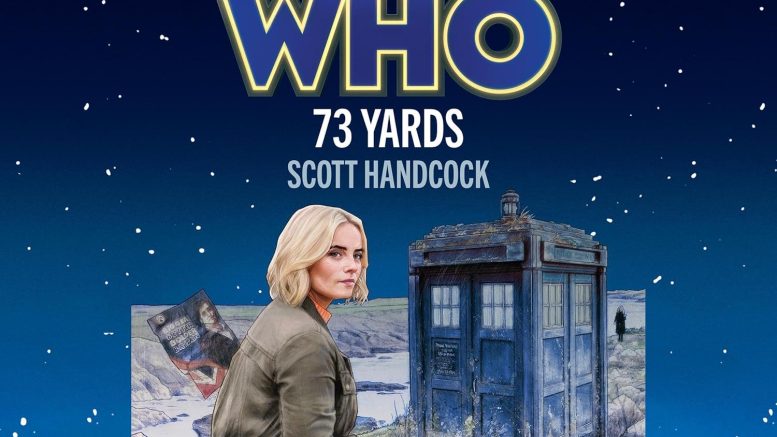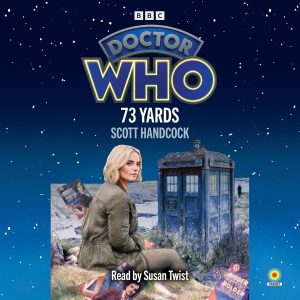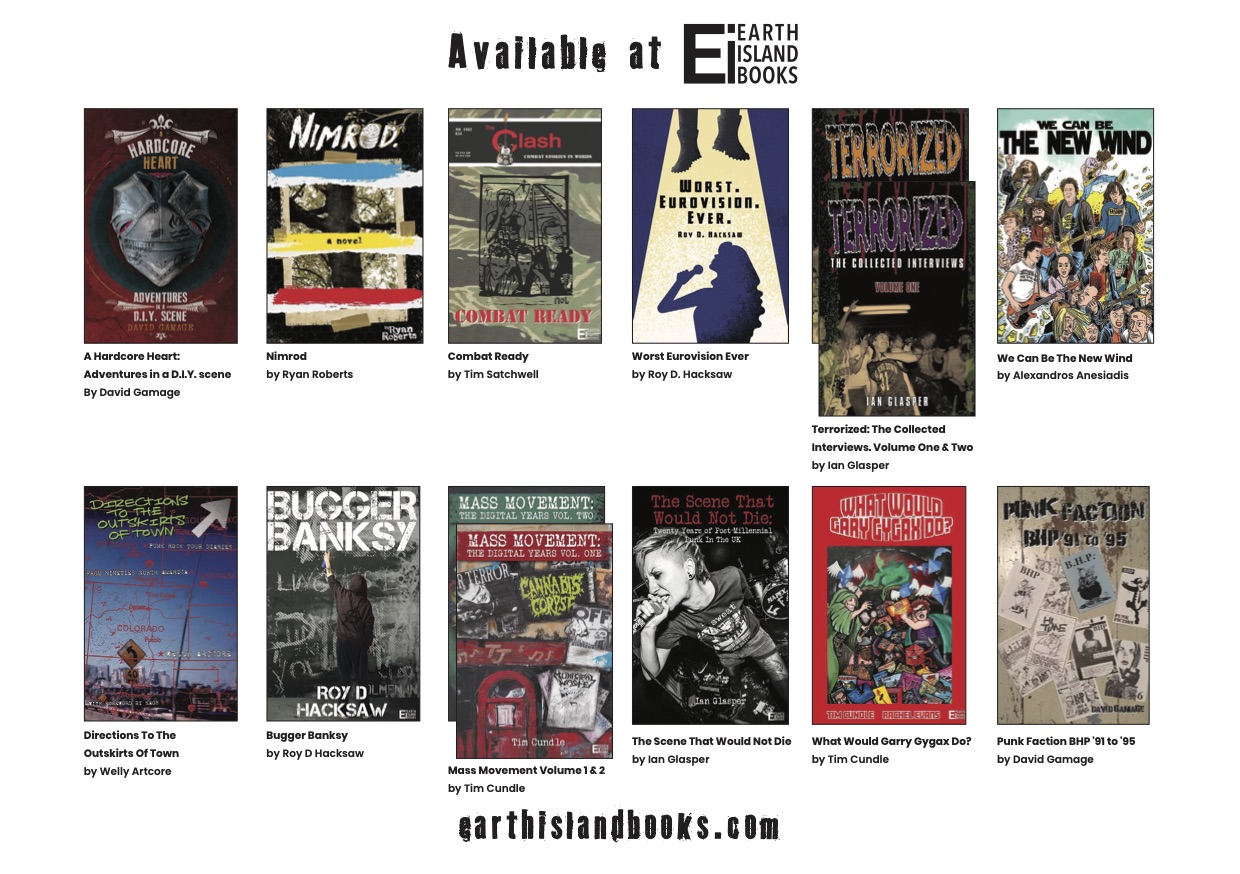73 Yards was a deeply peculiar Doctor Who story on-screen. In its main storyline, it was an excellent riff on Russell T Davies’ epic Years and Years with an effective folk horror twist. But in trying to connect its initial “Welsh fairy-ring and snotty locals” section with its “future Prime Minister, dystopian section,” the storytelling fell apart, and left many viewers grasping for relevance by the end. Not that viewers were looking for neat answers, necessarily – although some probably were – but it left some people with a sense that it could have worked, but…didn’t, quite, so what should have been a triumph ended up as more of a maddened, tantalized shrug.
Perhaps most among the latest group of Target-style novelizations of the Fifteenth Doctor’s first stories then, it’s a book that feels like it has work to do.
Scott Handcock takes to the work with gusto, but also with an awareness of where he can’t go – it would equally disappoint some viewers if, for instance, he were to freely invent the words of the woman who, after a trip to Wales, is suddenly and forever 73 yards away from Ruby. That would arguably go too far, and reduce the folk horror nature of the woman’s appearance and power.
He also can’t explicitly “fix” the issue that lies at the heart of the storytelling – the fact that all the initial folk horror build-up turns out to be nonsense, nothing more than a mean Welsh joke on Ruby the English girl, and yet it sets in motion a train of events that lasts the rest of Ruby’s life – the disappearance of the Doctor, the seeming “death” of the Tardis, the creepy woman who keeps her distance, the words she tells anyone who comes near her, and the devastating reactions of anyone who talks to her, with consequences which rip through Ruby’s life time and time again. It would be too much to “fix” this thing, because then the whole of 73 Yards would be shifted on its axis a little too far.
But here’s the thing. Handcock’s novelization has enough additional material to make it better than the on-screen version, to connect enough of the dots to deliver a deeper experience that nudges the story jusssst back over the line for those who felt the narrative connections were broken, without giving too much to blow the strangeness and the mystery for those who saw those elements as the main vibe of the piece.
That’s a clever high wire act at the very least, and the way it’s done is hardwired to please both kinds of viewers. Essentially, we spend a lot more time inside Ruby’s head, so for instance, sequences that in the TV version – both for time and to illuminate the isolation she feels – involved Ruby staring wistfully out of windows as her life went on and she couldn’t commit to anything or anyone, are here deepened by explanations of why she can’t settle, how it feels to have someone always with you but never close, and the potential consequences of their interaction with anyone about whom you dare to care.
We also get a clearer understanding of Ruby’s shifting relationship to the woman over time, and a sense of what the ghostly woman’s gestures are intended to say, which is more useful than you might imagine, because on screen, she was frustratingly, but necessarily, always too distant to really impart any particular message with her hand movements. Here, that at least is clarified, and while it’s not enough to break the spooky factor, it’s enough to fill one of the gaps that feel unnecessarily distancing to the viewer or reader.
There are joyous and darkening additions to the rest of the book, too – including a meeting between Ruby and Ace, and some post-Roger ap Gwilliam futurology that makes the point that even if you happen to depose the most dangerous Prime Minister of your age (as we’ve arguably done within living memory), the Earth is still in serious trouble. There’s a laugh-out-loud moment when we discover what Londoners, with their trademark sarcasm, call the UNIT Tower, and a sobering trip along Ruby’s timeline to the fall of that Tower into use as luxury flats. It all adds a richness and a stale-timeline brittleness to the piece which the TV version never had the scope to deliver.
Much of the rest of the book works by printing the legend – it’s worth remembering that the alternate timeline material with the rise of Roger ap Gwilliam is exceptionally relatable, especially as we have lived in what feels like a redundant timeline with dangerous and unstable Prime Ministers for over a decade. And it remains a brave decision not to collapse the timeline when Ruby uses the woman to despatch ap Gwilliam, but to force her to live on until she dies of old age.
There’s sliiiightly more made of the potential reasons why things have happened the way they have, with Kate’s pondering on perception filters interacting with fairy-rings and boundary lines resonating more in Ruby’s mind as she goes on. And while it’s not much, it’s just enough to cling to for those who need some sort of pseudo-sense to the story, while on-screen, it was almost made a throwaway line as events overtook Ruby.
While we never find out exactly what the woman says, there’s a significantly more detailed explanation of what hearing her speak at the end of Ruby’s life feels like, and that works well to deliver enough impact to pull the moment over from the convenient mystery of the TV version to at least an emotional resonance that satisfies when you hear it.
That’s the kind of thing we mean when we say Handcock does enough to make the story more satisfying without in fact fixing the storytelling leaps. He simply shades them better in the novelization by writing some things explicitly, which the TV version sought to convey with visuals or long looks from Millie Gibson.
In the end, there’s room and reason for both versions – once you’ve established the nature of the isolation Ruby feels, you can’t have her gabbling to everyone about it on-screen, because that would destroy the very isolation you’re trying to portray. But in the novelization, you can go inside her head and hear her thoughts, understand the emotional impact of this life lived lonely. Both work, but – at least for my money – the novelization works better because it has the space and the scope to give you more and bring you into that feeling and that lived experience.
In terms of the reader, it might seem a slightly odd choice to give this audiobook to Susan Twist (though only if we assume, for instance, that later stories in the run either aren’t being novelized or will be given to other readers). Twist though is a virtuoso delight, bending her performance to give us a slightly more Scottish Doctor, an effective Mancunian Ruby, and a host of Welsh characters, while giving the story quite enough oomph and quite enough loneliness to make it work well as a listening experience.
Do the pronunciations of the Welsh language lie in wait for her like evil potholes along the way? Oh, absolutely. In particular, the name of the Welsh pub of grotesques, Y Pren Marw – The Dead Tree – is a tripping hazard, because Twist pronounces Marw (Mar-ooo), the word for “Dead” as Mawr (M-ow-r), which just happens to be the Welsh word for “Big” or “Large.”
And let’s, for kindness, not bother about the pronunciation of the name of Welsh mythological hero, Twm Siôn Cati.
The point to keep firmly in your mind here is that unless you a) happen to be Welsh, and b) have far too much time on your hands, you’re either not going to know when the Welsh language springs its traps, or you’re not going to care.
So is the novelization and the audiobook of 73 Yards worth getting?
Absolutely, yes. If you thought the TV version was perfect, there’s enough here to deepen it for you without breaking the threads of mystery. If you felt it had a lot of potential but never quite nailed the landing, there’s enough here to give you a different experience of Ruby’s isolation, and to nudge you just far enough over the line to satisfaction without reducing the fundamental weirdness and the unnerving quality of the original.
Handcock is highly skilled in delivering a bulked-out but never broken version of the story, and he hits enough of those additional satisfaction points to make it work better than it did on-screen. Added to which, Twist on reading duties is something of a revelation in her easy, fluid characterisations (even though, given her multiple roles throughout the season, that should probably come as no surprise at all).
So whatever you thought of the on-screen version of this story, the novelization and the audiobook has extra goodness to give you. It’s fundamentally the same story, but it takes you in deeper and gives you a new way of travelling the timeline with Ruby Sunday, which is likely to please practically everyone. Tony Fyler





Be the first to comment on "Doctor Who: 73 Yards – Written by Scott Handcock & Read by Susan Twist (BBC Audio)"